International Journal of Computer Network and Information Security @ijcnis
Статьи журнала - International Journal of Computer Network and Information Security
Все статьи: 1177
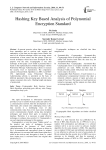
Hashing Key Based Analysis of Polynomial Encryption Standard
Статья научная
In present scenario, where data is transmitted from transmitter end to receiver end, security and authenticity of the data are the major issues. Hence, the need of an efficient technique which can assure secure transmission of data comes into the picture. There are several techniques which have been developed for this purpose over the time. Cryptography is one such technique. In this paper a new model is presented that is based on the implementation of Hash techniques with the Polynomial Message Authenticating scheme to increase the security level of transmission. The comparative analysis of Secure Hash Algorithms i.e. SHA-1 and SHA-256, implemented using Polynomial Message Authenticating scheme, is presented on the basis of different parameters like processing gain, delivery ratio, energy consumed, duty cycle, Hashing length and degree of polynomial.
Бесплатно
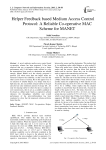
Helper Feedback based Medium Access Control Protocol: A Reliable Co-operative MAC Scheme for MANET
Статья научная
A novel multirate media access control based co-operative scheme has been proposed. It has been observed that any co-operative scheme gives a better performance only if the helper nodes selected to, relay the transmission from source to destination are reliable enough. Murad Khalid et.al has already proposed a protocol [24] where more than one helper nodes are selected to improve the reliability, so that if one fails the other can be used as a backup. But in this paper focus is on selection of reliable helpers. If a helper node has a high data rate, has successfully relayed traffic in the past and also has some minimum amount of energy left , not only for relaying traffic for others but also to conduct its own transmissions, then it acts as a suitable candidate to be chosen as a helper node. Such a co-operatives scheme enhances the throughput, reliability and overall performance of the network.Simulation has been conducted to show that the proposed scheme performs better than the.
Бесплатно
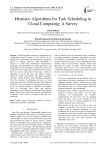
Heuristic Algorithms for Task Scheduling in Cloud Computing: A Survey
Статья научная
Cloud computing became so important due to virtualization and IT systems in this decade. It has introduced as a distributed and heterogeneous computing pattern to sharing resources. Task Scheduling is necessary to make high performance heterogeneous computing. The optimization of related parameters, and using heuristic and meta-heuristic algorithms can lead to a reduction of the search space complexity and execution time. So, several studies have tried using a variety of algorithms to solve this issue and improve relative efficiency in their environments. This paper considered examines existing heuristic task scheduling algorithms. First, the concepts of scheduling, the layer of cloud computing, especially scheduling concept in the SaaS and PaaS layer, the main limits for improving the quality of service, evaluation methods of algorithms and applied tools for evaluating these ideas and practical experimental used methods were discussed and compared. Finally, future works in this area were also concluded and a summary of this article is presented in the form of a mind map.
Бесплатно
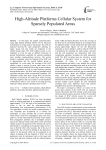
High-Altitude Platforms Cellular System for Sparsely Populated Areas
Статья научная
In this paper, the cellular communications using high altitude platform (HAP) will be discussed including the coverage analysis and design. The cells are analyzed showing the main parameters affecting its shape, layout and area which are important in the cellular design stage. This HAP cellular system is very important to cross the gap of difficult extension of ground infrastructure especially for sparsely populated areas needing communications services. The system design is explained where the footprint of the HAP cell is demonstrated and the overall cellular layout is established. As a case study, the coverage of the HAP cellular system is proved to cover some areas in the Kingdom of Saudi Arabia (KSA) using several scenarios such as populated as well as long highways passing through desert areas. The HAP cells are generated using spot-beam antennas which are practically candidate. The simulation results show that a single HAP can provide hundreds of microcells for urban areas while covering very long highways that can extend to several hundreds of kilometers which is very useful in covering the long highways linking sparsely separated cities in KSA.
Бесплатно

High-Speed and Secure PRNG for Cryptographic Applications
Статья научная
Due to the fundamentally different approach underlying quantum cryptography (QC), it has not only become competitive, but also has significant advantages over traditional cryptography methods. Such significant advantage as theoretical and informational stability is achieved through the use of unique quantum particles and the inviolability of quantum physics postulates, in addition it does not depend on the intruder computational capabilities. However, even with such impressive reliability results, QC methods have some disadvantages. For instance, such promising trend as quantum secure direct communication – eliminates the problem of key distribution, since it allows to transmit information by open channel without encrypting it. However, in these protocols, each bit is confidential and should not be compromised, therefore, the requirements for protocol stability are increasing and additional security methods are needed. For a whole class of methods to ensure qutrit QC protocols stability, reliable trit generation method is required. In this paper authors have developed and studied trit generation method and software tool TriGen v.2.0 PRNG. Developed PRNG is important for various practical cryptographic applications (for example, trit QC systems, IoT and Blockchain technologies). Future research can be related with developing fully functional version of testing technique and software tool.
Бесплатно
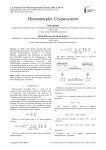
Статья научная
In 2009 Craig Gentry proved that Fully Homomorphic Encryption can be applied and realized in principle. Homomorphism allowed us to perform arbitrary computations and calculations on encrypted data. With RSA being the first cryptosystem to hold homomorphic properties, there came other additive and multiplicative cryptosystems. However, fully Homomorphic encryption proved to be the ultimate cryptographic solution to ensure security of data on cloud. It enables processing and computing arbitrary functions over the encrypted data thereby reducing the probability of accessing the plain text.
Бесплатно
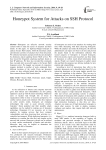
Honeypot System for Attacks on SSH Protocol
Статья научная
Honeypots are effective network security systems built to study the tactics of attackers and their intents. In this paper, we deployed Kippo honeypot to analyze Secure Shell attacks. Both the dictionary attack and intrusion activities of attackers have been discussed. We collected usernames and passwords that are attempted by dictionary attack targeting Secure Shell service. We have traced the frequently attacking machines based on their IP addresses. We have also recorded the commands they executed after successful logins to the Secure Shell honeypot server. We logged vast amount of connection requests destined to number of ports originated from different locations of the world. From our honeypot system, we have collected attack data that enables us to learn common Secure Shell based attacks.
Бесплатно
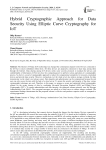
Hybrid Cryptographic Approach for Data Security Using Elliptic Curve Cryptography for IoT
Статья научная
The Internet of Things (IoT) technology has changed the contemporary digital world. Devices connected to the IoT have sensors embedded within them. All these devices are purposely connected to share data among them through the Internet. Data sharing among IoT devices needs some security protocols to maintain the privacy and confidentiality of information. IoT devices have less computing power to perform various operations of a cryptographic process. So, there is a need of cryptographic approach to reduce the computational complexity for resource-constrained devices and provide data security. However, storing data over the cloud server also reduces storage overhead, but data transmission via the cloud is not always secure. Data integrity and authentication can be compromised because the end user can only access the data with the help of a cloud server. To ensure the security and integrity of the data, various cryptographic techniques are used. Therefore, in this paper, we propose a secure and optimized hybrid cryptographic scheme for the secure sharing of data by combining Advanced Encryption Standard (AES) and Elliptic Curve Cryptography (ECC). To ensure authentication and data integrity, the proposed scheme primarily uses the Message Authentication Code (MAC). The encrypted messages are stored on a cloud server to reduce storage overhead. The experimental findings demonstrate that the proposed scheme is effective and produces superior results as compared to existing approaches.
Бесплатно
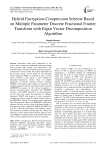
Статья научная
Encryption along with compression is the process used to secure any multimedia content processing with minimum data storage and transmission. The transforms plays vital role for optimizing any encryption-compression systems. Earlier the original information in the existing security system based on the fractional Fourier transform (FRFT) is protected by only a certain order of FRFT. In this article, a novel method for encryption-compression scheme based on multiple parameters of discrete fractional Fourier transform (DFRFT) with random phase matrices is proposed. The multiple-parameter discrete fractional Fourier transform (MPDFRFT) possesses all the desired properties of discrete fractional Fourier transform. The MPDFRFT converts to the DFRFT when all of its order parameters are the same. We exploit the properties of multiple-parameter DFRFT and propose a novel encryption-compression scheme using the double random phase in the MPDFRFT domain for encryption and compression data. The proposed scheme with MPDFRFT significantly enhances the data security along with image quality of decompressed image compared to DFRFT and FRFT and it shows consistent performance with different images. The numerical simulations demonstrate the validity and efficiency of this scheme based on Peak signal to noise ratio (PSNR), Compression ratio (CR) and the robustness of the schemes against bruit force attack is examined.
Бесплатно

Статья научная
Wireless Sensor Networks (WSNs) are one of the most researched areas worldwide as the wide-scale networks possess low cost, are small in size, consume low power, and can be deployed in various environments. Among various applications of WSNs, target tracking is a highly demanding and broadly investigated application of wireless sensor networks. The parameter of accurate tracking is restricted because of the limited resources present in the wireless sensor networks, noise of the network, environmental factors, and faulty sensor nodes. Our work aims to enhance the accuracy of the tracking process as well as energy utilization by combing the mechanism of clustering with the prediction. Here, we present a hybrid energy-regulated constant gain Kalman filter-based target detection and tracking method, which is an algorithm to make the best use of energy and enhance precision in tracking. Our proposed algorithm is compared with the existing approaches where it is observed that the proposed technique possesses efficient energy utilization by decreasing the transference of unimportant data within the sensor network, achieving accurate results.
Бесплатно
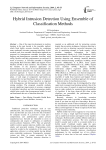
Hybrid Intrusion Detection Using Ensemble of Classification Methods
Статья научная
One of the major developments in machine learning in the past decade is the ensemble method, which finds highly accurate classifier by combining many moderately accurate component classifiers. In this research work, new ensemble classification methods are proposed for homogeneous ensemble classifiers using bagging and heterogeneous ensemble classifiers using arcing classifier and their performances are analyzed in terms of accuracy. A Classifier ensemble is designed using Radial Basis Function (RBF) and Support Vector Machine (SVM) as base classifiers. The feasibility and the benefits of the proposed approaches are demonstrated by the means of real and benchmark data sets of intrusion detection. The main originality of the proposed approach is based on three main parts: preprocessing phase, classification phase and combining phase. A wide range of comparative experiments are conducted for real and benchmark data sets of intrusion detection. The accuracy of base classifiers is compared with homogeneous and heterogeneous models for data mining problem. The proposed ensemble methods provide significant improvement of accuracy compared to individual classifiers and also heterogeneous models exhibit better results than homogeneous models for real and benchmark data sets of intrusion detection.
Бесплатно
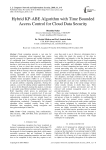
Hybrid KP-ABE algorithm with time bounded access control for cloud data security
Статья научная
Cloud computing presents a vast area for distributed computing where integrated data centres provide resources for immense and scalable distribution of confidential data. Conceptually, cloud applications being offered, information security and its confidentiality become a vital issue to the cloud. So, as to craft certain security of data at cloud data stowage a design and execution of an algorithmic rule to boost cloud security is planned. With an concept, where the planned algorithmic rule integrates option of three completely different existing algorithms and named RAD cryptography algorithm with most novel and attractive conception of Attribute based encryption (ABE) so as to manage, control access and file sharing management in cloud with its special attribute computing properties. During this analysis, a secure file sharing scheme supported attribute is given. In this Research, during this analysis, work data is encrypted using Hybrid attribute based algorithm i.e. RAD Algorithm which proves its proficiency and effectiveness with respect to security level. If any user wants to access the encrypted information where some authentication credentials also are created based on cipher-text, then it has to evidence itself by providing authentication credentials. Consequently, the planned algorithm offers enriched security along with it diminishes time complexity during encryption and decryption technique for data file.
Бесплатно
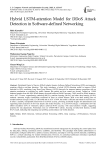
Hybrid LSTM-attention Model for DDoS Attack Detection in Software-defined Networking
Статья научная
Distributed Denial of Service (DDoS) attacks threaten Software-Defined Networking (SDN) environments, requiring effective real-time detection. This study introduces a hybrid LSTM-Attention model to improve DDoS detection in SDN, combining Long Short-Term Memory (LSTM) networks for temporal pattern recognition with an attention mechanism to prioritize key traffic features like packet and byte counts per second. Trained on 15,000 balanced samples from the SDN DDoS dataset, the model achieved 96.90% accuracy, 100% recall for DDoS instances, and a 0.97 F1-score, outperforming statistical (88.5%), machine learning (94.0%), and other deep learning (95.0%) methods. Attention weight visualization confirmed its focus on critical features. With a two-hour training time on modest hardware (Google Colab, 12 GB RAM) and an AUC of 0.99, the model is efficient and robust for real-time use. It offers a scalable, interpretable framework for network security, providing actionable insights for administrators and supporting future detection of slow-rate attacks and insider breaches. As a proof-of-concept, a subsampled slow-rate DDoS simulation (10% of volumetric spikes) achieved 89.5% accuracy with tuned attention weights, suggesting potential for rate adjustments. Preliminary tests on UNSW-NB15 subsets, focusing on behavioral features, yielded 85.2% recall, indicating that integrating user profiling could enhance real-world detection.
Бесплатно
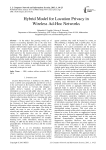
Hybrid Model for Location Privacy in Wireless Ad-Hoc Networks
Статья научная
In the today's fast growing world, use of internet is increasing popularly and at the same time Location-based services (LBS) are also getting more popular. LBS providers require user's current locations to answer their location-based queries. The primary objective of the present work is to develop a system which preserves the location privacy of the concerned individual. This objective is achieved by simulating locally cloak algorithm and globally cloak algorithm for Manhattan mobility model and Waypoint mobility model using NS-2.34 environment. In the experiments, to hide the user's current locations in rectangle [bounding box] according to users privacy need, obfuscation and k-anonymity strategies are used.
Бесплатно
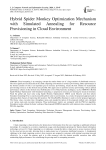
Статья научная
Cloud computing is an emerging concept that makes better use of a large number of distributed resources. The most significant issue that affects the cloud computing environment is resource provisioning. Better performance in the shortest amount of time is an important goal in resource provisioning. Create the best solution for dynamically provisioning resources in the shortest time possible. This paper aims to perform resource provisioning with an optimal performance solution in the shortest time. Hybridization of two Meta-heuristics techniques, such as HSMOSA (Hybrid Spider Monkey Optimization with Simulated Annealing), is proposed in resource provisioning for cloud environment. Finds the global and local value using Spider Monkey Optimization's (SMO) social behavior and then utilizes Simulated Annealing (SA) to search around the global value in each iteration. As a result, the proposed approach aids in enhancing their chances of improving their position. The CloudSimPlus Simulator is used to test the proposed approach. The fitness value, execution time, throughput, mean, and standard deviation of the proposed method were calculated over various tasks and execution iterations. These performance metrics are compared with the PSO-SA algorithm. Simulation results validate the better working of the proposed HSMOSA algorithm with minimum time compared to the PSO-SA algorithm.
Бесплатно
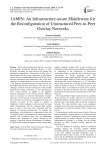
Статья научная
Peer to peer networks have become one of the most popular networking methods because of their flexibility and many use cases such as file sharing and distributed computations. Unstructured overlay peer to peer networks are one of key components of peer to peer systems that are considerable because of their low cost in network construction and maintenance. One of the main challenges in unstructured peer to peer overlay networks is the topology mismatch between overlay network and the underlying physical infrastructure. The root of this challenge is lack of awareness about peers in the network infrastructure during connection to and disconnection from overlay network, in addition to the neighbor selection mechanism in the overlay network. Different types of awareness of network infrastructure includes awareness of the location of internet service providers. Also awareness of proximity, geographical location and resources of peers. In this article we present a middleware which configures overlay network by using public measurements and the estimated delay among peers in order to have the most conformity with the topology of physical infrastructure. To evaluate the performance, our middleware is implemented on the top of Gnutella which is an unstructured overlay peer-to-peer network. Our simulations show that our middleware enhances the conformity of overlay network to the topology of physical network infrastructure. In addition, it improved the average throughput and the average delay.
Бесплатно
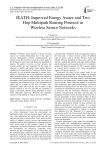
IEATH: Improved Energy Aware and Two Hop Multipath Routing Protocol in Wireless Sensor Networks
Статья научная
Wireless sensor networks in terms of energy sources are limited. Furthermore due to this type of network infrastructure wireless communications and channel errors not possible to reach the correct packet to the destination exists; hence the proposing algorithms to improve the quality of service in these networks and sending packets are very important. In this paper we proposed a reliable and energy aware packet delivery mechanism to ensure quality of service in wireless sensor networks. In our proposed algorithm to ensure that a packet of information sent to the destination, the multi-path Forwarding method is used; So that several copies of an information packet via separate routes are sent to the destination, also routing decisions in this way occurs by considering the remaining energy in the neighborhood of nodes that are located in two hop of sender node. Simulation results show that the rate of release of data packets reduced in this way and thus the reliability of packet is increased, also the energy efficiency of sensor nodes effectively improved. Therefore this algorithm increase overall lifetime in wireless sensor networks.
Бесплатно

IHBOT: An Intelligent and Hybrid Model for Investigation and Classification of IoT Botnet
Статья научная
The Internet of Things (IoT) is revolutionizing the technological market with exponential growth year wise. This revolution of IoT applications has also brought hackers and malware to gain remote access to IoT devices. The security of IoT systems has become more critical for consumers and businesses because of their inherent heterogenous design and open interfaces. Since the release of Mirai in 2016, IoT malware has gained an exponential growth rate. As IoT system and their infrastructure have become critical resources that triggers IoT malware injected by various shareholders in different settings. The enormous applications cause flooding of insecure packets and commands that fueled threats for IoT applications. IoT botnet is one of the most critical malwares that keeps evolving with the network traffic and may harm the privacy of IoT devices. In this work, we presented several sets of malware analysis mechanisms to understand the behavior of IoT malware. We devise an intelligent and hybrid model (IHBOT) that integrates the malware analysis and distinct machine learning algorithms for the identification and classification of the different IoT malware family based on network traffic. The clustering mechanism is also integrated with the proposed model for the identification of malware families based on similarity index. We have also applied YARA rules for the mitigation of IoT botnet traffic.
Бесплатно
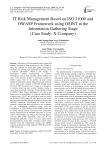
Статья научная
The major IT developments lead to speed and mobility elevation of information access. One of them is using the website to share and gather information. Therefore, the mobility and information disclosure create a harmful vulnerability. Which is the leakage of information, whether organizational or sensitive information, such as bank accounts, phone number and many more. Security testing is necessarily needed on website usage. One of the website security testing method is penetration testing. Supporting framework that can be used in this method is OWASP Testing Guide Version 4. OTG Version 4 has 11 stages cover all aspects of website protection and security. Security testing is nicely done using tools / software. Tools with the concept of OSINT (Open Source Intelligence) are used to get better access and availability by using the characteristics of open source. The IT risk assessment analysis carried out by ISO 31000 framework and based on the results that have been obtained through penetration testing with OWASP framework. Significance & values of this research is finding the best and effective way to making IT risk management guidelines along with the combination of with OWASP & ISO 31000 framework, by doing website security assessment with penetration testing method based on OWASP framework to get the system vulnerabilities and analyze the risks that appears with the ISO 31000 framework. Also, the IT risk management guidelines consist of system improvement recommendations along with evaluation report which obtained from the collaboration analysis the OSINT concept, penetration testing methods, OWASP and ISO 31000 framework.
Бесплатно
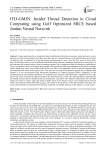
Статья научная
Cloud computing refers to a high-level network architecture that allows consumers, authorized users, owners, and users to swiftly access and store their data. These days, the user's internal risks have a significant impact on this cloud. An intrusive party is established as a network member and presented as a user. Once they have access to the network, they will attempt to attack or steal confidential information while others are exchanging information or conversing. For the cloud network's external security, there are numerous options. But it's important to deal with internal or insider threats. Thus in the proposed work, an advanced deep learning with optimized missing value imputation is developed to mitigate insider thread in the cloud system. Behavioral log files were taken in an organization which is split into sequential data and standalone data based on the login process. This data was not ready for the detection process due to improper data samples so it was pre-processed using Multivariate Imputation by Chained Equations (MICE) imputation. In this imputation process, the estimation parameter was optimally chosen using the Golf Optimization Algorithm (GOA). After the missing values were filled, the data proceeded to the extraction process. In this, the sequential data are proceeded for the domain extractor and the standalone data are proceeded for Long Short-Term Memory-Autoencoder (LS-AE). Both features are fused to create a single data which is further given to the detection process using Jordan Neural Network (JNN). The proposed method offers 96% accuracy, 92% recall, 91.6% specificity, 8.39% fall out and 8% Miss Rate. The results showed that the recommended JNN detection model has successfully detected insider threads in a cloud system.
Бесплатно

